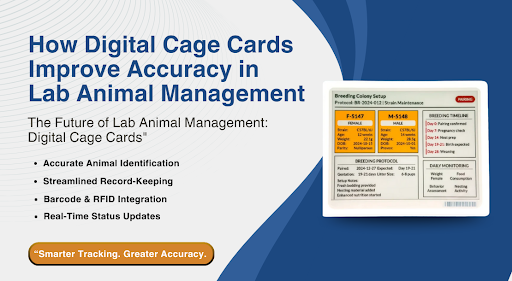
25 Aug How Digital Cage Cards Improve Accuracy in Lab Animal Management
In lab animal research, precision is paramount. From breeding calendars and medical
interventions to cage counts and compliance documentation, the slightest mistake can
jeopardize animal well-being and research results. Animal labs used conventional paper cage
cards for decades to manage this critical information. While straightforward and comforting,
these cards tended to generate inefficiencies and inconsistencies that affected workflow as well
as data integrity.
Today, facilities are making a significant leap forward by adopting digital cage card and
electronic cage card systems. These modern solutions are transforming lab animal
management, providing real-time updates, reducing errors, and ensuring compliance with
regulatory standards.
In this blog, we’ll explore how digital cage cards improve accuracy in animal labs and why they
are quickly becoming the gold standard for managing data at the cage level.
The Drawbacks of Conventional Paper Cage Cards
Paper cage cards have been the backbone of animal facility records for years. They capture
vital information like animal ID, strain, cage number, breeding history, and medical treatment.
Yet, they possess some major drawbacks:
● Subject to human error – Handwritten records are usually hard to decipher,
incomplete, or in error.
● Inadequacy in real-time accuracy – Revisions could take days or even hours to catch
up with the cage card, leaving stale information in circulation.
● Risk of loss or damage – Paper can be damaged, smudged, or lost, causing missing or
incomplete information.
● No audit trail – History tracking and accountability are close to impossible using manual
cards.
● Labour-intensive processes – Replacing, rewriting, and collating cage cards takes
time and raises the risk of errors.
These are the limitations that make it necessary for a brighter, more dependable system that is
accurate at each stage.
What Is a Digital Cage Card?
A digital cage card is a computer display that substitutes for paper cards attached to animal
cages. Transmitted wirelessly to an animal management system, the cards update automatically
as soon as data is modified in the system.
An electronic cage card generally shows:
● Animal ID and strain information
● Breeding and litter information
● Medical histories and treatment schedules
● Task reminders and notifications
● Cage inventory or capacity information
In contrast to static paper cards, these displays are dynamic and interactive, making it certain
that the information displayed on the cage is continually accurate, complete, and up-to-date.
How Digital Cage Cards Enhance Accuracy
Real-Time Updates at the Cage Level
Perhaps the best aspect of a digital cage card is its capacity to present information in real time.
The instant a researcher or technician makes a change to data within the management
software—e.g., marks a treatment, weans a litter, or sets a cage change, the information
immediately updates on the electronic cage card.
This provides all employees with the same, most current data instantly, avoiding the
Inconsistencies of paper systems.
Reducing Human Error
Hand transcription and handwritten notes are frequent causes of error in animal labs. With
electronic cage cards, the chance is significantly minimized. Data is entered into the central
system once and then automatically transferred to the electronic screen.
By eliminating duplicated data entry and handwriting, electronic cage cards make sure to are
accuracy, legibility, and uniformity for all the cages in the facility.
Transparent and Traceable Records
Computer systems leave a total audit trail of all activities performed. It may be a breeding
update, health treatment, or transferring a cage; everything gets recorded with time stamps and
user identification.
This level of openness allows for easy monitoring of responsibility, detection of discrepancies,
and staying in line with regulatory requirements. It also makes inspections and audits a breeze,
as proper records are always at hand.
Built-In Alerts and Notifications
Accuracy is not only a matter of documenting what’s already occurred, but it’s also about
reminding personnel what needs to occur. Most electronic cage cards contain alert features that
flash or highlight future tasks like treatments, weaning dates, or cage changes.
These forward-thinking reminders avoid oversights and confirm that significant actions are taken on
time, further enhancing accuracy in animal care and documentation.
Enhanced Communication Across Teams
Animal labs typically consist of several teams, including researchers, technicians, and
veterinarians. With miscommunication among these groups, record inconsistency can be an
issue.
Everyone gets to view the same information, in real-time, updated, with digital cage cards. The
visibility across the board eliminates misinterpretations, keeps stakeholders on the same page,
and provides consistency in animal management practices.
Integration with Lab Management Systems
The majority of digital cage card solutions have been developed to be integrated with animal
management systems. In this way, the cage-level displays are not individual stand-alone tools
but rather a component of an extensive digital ecosystem.
From breeding program planning to monitoring facility capacity, the integration guarantees
precision at each level of data management, cage, room, and facility.
Case Example: Smarter Accuracy with CageTalkers
One of the top solutions in this area is CageTalkers, a system that marries digital cage card
technology with real-time, multi-page displays. CageTalkers delivers three screens of data at
the cage level, from identification and breeding to medical treatments and alerts.
By synchronizing with the lab’s management software, CageTalkers makes sure all the cages
show the most recent and correct information. With automated alarms, audit-ready
documentation, and real-time updates, it is a classic demonstration of how electronic cage cards
improve precision and productivity in animal laboratories.
The Future of Cage Documentation
With research settings becoming more complicated and compliance increasing, the transition to
electronic cage cards is inevitable. Electronic systems not only make information more accurate
but also conserve time, avoid audit stresses, and promote better animal welfare by leaving no
detail behind.
In the future, we can anticipate these tools being further developed with AI-driven
analytics, IoT integration, and cloud-based reporting. This will get the animal management even
smarter, more efficient, and more transparent.
Conclusion
Accuracy in animal laboratories is not up for debate. Paper cage cards, which were useful in the
past, are no longer sufficient for today’s facilities. Implementing digital cage cards and electronic
cage cards allows laboratories to have real-time visibility, open records, and error-free
documentation that enhances research results as well as animal care.
The way ahead is clear: paper is out, and digital is in. For labs interested in improving accuracy,
compliance, and efficiency, the digital cage card is not only an upgrade, it’s a revolution in cage
documentation.


